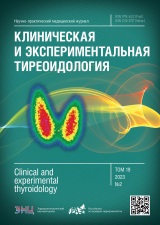
Reviews
Differentiated thyroid cancer (DTC) is one of the most common malignancies within the endocrine system, with a progressively increasing incidence over recent decades. In the structure of DTC, occurrence in the pediatric age group is relatively rare and is associated with excellent prognoses in terms of disease-specific survival. However, the prevalence of advanced disease in children and the frequency of recurrences present interdisciplinary teams with questions regarding the optimal management approach for such patients, focusing not on achieving disease eradication but preserving and maintaining quality of life. Notably, the presence of oncological pathology, coupled with fluctuations in thyroid hormone levels due to therapeutic interventions, underscores the importance of maintaining psychological and physiological well-being that are affected by the increased frequency of anxiety and depressive symptoms in children and their parents, as well as cognitive and physical functioning. These symptoms may exacerbate against the backdrop of hypothyroidism and directly correlate with TSH levels. To maintain quality of life during the period of dynamic observation and risk group re-stratification, we proposed a method of reduced thyroid hormone doses as an alternative to discontinuing thyroid hormones to assess stimulated thyroglobulin when reaching a threshold TSH level >30 mIU/L. The method was implemented in 2 pediatric patients, showing positive outcomes in terms of absence of hypothyroidism-related complaints, preservation of free thyroid hormone fractions, achievement of adequate target TSH levels, and informative tumor marker indicators. The results of our study underscore the importance of an individualized approach to the management of children with DTC and demonstrate the potential effectiveness of the reduced dose method in maintaining the quality of life of these patients. Further research and clinical observations are necessary for a deeper understanding of the applicability of this method and its impact on longterm outcomes.
Tobacco smoking has been a global health problem for many years. It has especially worsened since the mass production of tobacco products. Tobacco smoking provokes various diseases, including endocrine diseases, and contributes to their progression. It is now known about the role of genetic predisposition to the development of thyroid pathology and the potential role of various environmental factors in the manifestation of thyroid diseases. Along with iodine intake, tobacco smoking is a significant risk factor affecting the functional status and volume of the thyroid gland. The introduction of electronic cigarettes as an alternative to tobacco products has raised a legitimate question: what effect do they have on thyroid status? The current literature review highlights current knowledge on the effects of smoking on the thyroid, including its relationship to changes in thyroid function and the development and progression of thyroid disorders.
Case Report
Autoimmune polyglandular syndrome type 1 (APS 1) is a rare genetic disorder caused by a mutation in the autoimmune regulator AIRE gene. The diagnosis is usually based on the combination of at least two components of the classic triad: mucocutaneous candidiasis, hypoparathyroidism, and primary adrenal insufficiency. Other autoimmune disorders, including thyroid diseases, also occur and may manifest before the primary components. The disease is more likely to manifest during infancy, but some components may develop in adult patients. As the components of the syndrome do not occur simultaneously, verification of the diagnosis is often delayed. A significant challenge in the management of patients with APS 1 is the selection of optimal drug doses due to polypragmasy and the frequent presence of autoimmune disorders and/or candidiasis of the gastrointestinal tract. We present a clinical case of a patient with an atypical course of APS 1, in whom the first endocrine components (hypoparathyroidism and hypothyroidism) were diagnosed in adulthood. This case highlights the phenotypic diversity of APS 1, and the difficulties in selecting therapy when several autoimmune endocrine diseases are combined.

This work is licensed under a Creative Commons Attribution-NonCommercial-NoDerivatives 4.0 International License (CC BY-NC-ND 4.0).
ISSN 2310-3787 (Online)





































